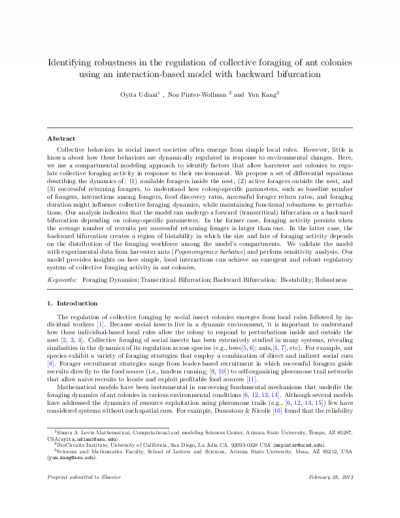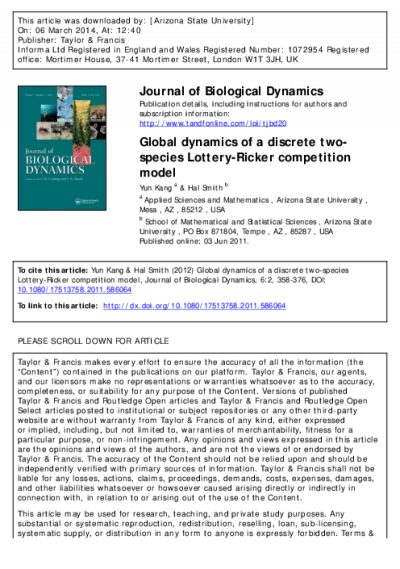The domain dependence of chemotaxis in a two-dimensional turbulent flow

- Author (aut): Jones, Kimberly
- Thesis advisor (ths): Tang, Wenbo
- Committee member: Kang, Yun
- Committee member: Jones, Donald
- Publisher (pbl): Arizona State University


Collective behaviors in social insect societies often emerge from simple local rules. However, little is known about how these behaviors are dynamically regulated in response to environmental changes. Here, we use a compartmental modeling approach to identify factors that allow harvester ant colonies to regulate collective foraging activity in response to their environment. We propose a set of differential equations describing the dynamics of: (1) available foragers inside the nest, (2) active foragers outside the nest, and (3) successful returning foragers, to understand how colony-specific parameters, such as baseline number of foragers, interactions among foragers, food discovery rates, successful forager return rates, and foraging duration might influence collective foraging dynamics, while maintaining functional robustness to perturbations. Our analysis indicates that the model can undergo a forward (transcritical) bifurcation or a backward bifurcation depending on colony-specific parameters. In the former case, foraging activity persists when the average number of recruits per successful returning forager is larger than one. In the latter case, the backward bifurcation creates a region of bistability in which the size and fate of foraging activity depends on the distribution of the foraging workforce among the model׳s compartments. We validate the model with experimental data from harvester ants (Pogonomyrmex barbatus) and perform sensitivity analysis. Our model provides insights on how simple, local interactions can achieve an emergent and robust regulatory system of collective foraging activity in ant colonies.





The per-capita growth rate of a species is influenced by density-independent, positive and negative density-dependent factors. These factors can lead to nonlinearity with a consequence that species may process multiple nontrivial equilibria in its single state (e.g., Allee effects). This makes the study of permanence of discrete-time multi-species population models very challenging due to the complex boundary dynamics. In this paper, we explore the permanence of a general discrete-time two-species-interaction model with nonlinear per-capita growth rates for the first time. We find a simple sufficient condition for guaranteeing the permanence of the system by applying and extending the ecological concept of the relative nonlinearity to estimate systems' external Lyapunov exponents. Our method allows us to fully characterize the effects of nonlinearities in the per-capita growth functions and implies that the fluctuated populations may devastate the permanence of systems and lead to multiple attractors. These results are illustrated with specific two species competition and predator-prey models with generic nonlinear per-capita growth functions. Finally, we discuss the potential biological implications of our results.

In this article, we study the global dynamics of a discrete two-dimensional competition model. We give sufficient conditions on the persistence of one species and the existence of local asymptotically stable interior period-2 orbit for this system. Moreover, we show that for a certain parameter range, there exists a compact interior attractor that attracts all interior points except Lebesgue measure zero set. This result gives a weaker form of coexistence which is referred to as relative permanence. This new concept of coexistence combined with numerical simulations strongly suggests that the basin of attraction of the locally asymptotically stable interior period-2 orbit is an infinite union of connected components. This idea may apply to many other ecological models. Finally, we discuss the generic dynamical structure that gives relative permanence.

